Scientific name: Caryopteris x clandonensis
Plant Family: Mint (Lamiaceae) , formerly in the Verbena (Verbenaceae) plant family
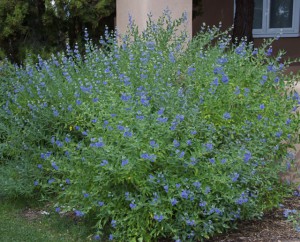
Caryopteris x clandonensis cultivar (Photo by Janice Tucker)
Common name: Blue Mist spirea
Article by Janice Tucker
Photos by Janice Tucker and Tracy Neal
The flowers of the Blue Mist spirea (Caryopteris x clandonensis) appear as if a little bit of a clear, blue New Mexico sky floated down to earth to take up residence in a garden.
Native to eastern and southern Asia, the Caryopteris x clandonensis was first introduced to the United States in the 1960s and soon became a favorite in the home garden. It is especially popular in locations with dry climates, making it a staple in Santa Fe residential and commercial landscapes. Learn more about popular New Mexico landscape plants through the centuries at the Santa Fe Botanical Garden lecture on April 11.
The Blue Mist spirea (Caryopteris x clandonensis) is a deciduous, perennial shrub that grows to a height of 3 to 5 feet in most areas but has been known to grow taller in certain environments. The opposite, gray-green, lance-shaped leaves are serrated along the margins and often fragrant. In the summer, clusters of blue flowers grow up the top third of the stems. The flowers appear at the axis of two leaves and also at the tip end of the stem, creating a vision of color ranging in shades of light to dark purple-blue, depending on the cultivar. Bumblebees, butterflies and hummingbirds are attracted to the flowers. The fruit is a four-valved capsule, with each valve containing one seed.
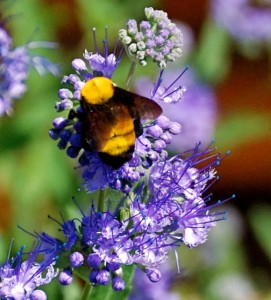
Bee on Caryopteris (Photo by Janice Tucker)
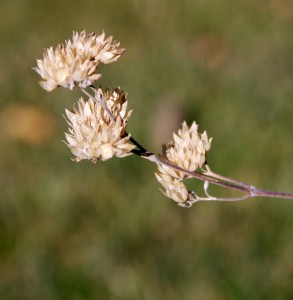
Caryopteris flower in winter (Photo by Janice Tucker)
The Blue Mist spirea blooms profusely into early fall. As the weather turns cooler, its leaves will drop and the flowers develop a papery texture with a lovely wheat color. Many gardeners allow the dried flowers to remain in order to provide interest in the winter garden.
The Blue Mist spirea should be planted in moist, well-drained soil and exposed to full sun in order to maximize blooms. It can happily exist in light shade where it is more drought tolerant although it will not bloom quite as prolifically. Overwatering will cause root rot. Too much fertilizer may result in vigorous growth but fewer blooms. Because the flowers appear on new growth it is best to cut the shrub back to at least one-third or one-half its height each spring after the threat of frost has passed. This pruning will encourage a more robust blooming season each year and serve to keep the plant’s growth habit well formed.
The cross between the C. incana and the C. mongholica that created the hybrid Caryopteris x clandonensis happened quite accidentally. In 1930 Arthur Simmonds, an Englishman from Clandon near Guilford, Surrey, collected seeds to propagate the C. mongholica. However, the C. incana must have been in the same general area from where he collected seeds. The result of that particular propagation was the cross between the C. incana and the C mongholica. Even though this hybridization was accidental, it went on to win several Royal Horticulture Society medals in 1933. Clandonensis is named for Clandon where the hybrid first appeared. Among the many popular cultivars that have been developed from this hybrid are: ’Blue Mist’, ‘Heavenly Blue’, ‘Longwood Blue’, ‘Dark Knight’, ‘Summer Sorbet’ and ‘Pershore’. The ‘Dark Knight’ is on the collections list for the Santa Fe Botanical Garden at Museum Hill – Welcome Garden.
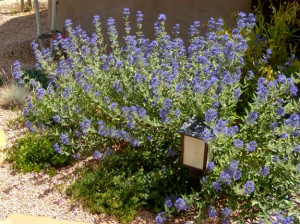
Caryopteris ‘Dark Knight’ (Photo by Tracy Neal)
The genus Caryopteris stems from the two Greek words of kayron(nut) and pteron(wing), referring to the winged fruit. The Caryopteris seems to be one of those plants in chronic flux with taxonomist. It has recently moved from the Verbenaceae (Verbena) plant family into the Laminaceae (Mint) family. According to the Missouri Botanical Garden’s esteemed plant list (theplantlist.org), the status of the name Caryopteris x clandonensis is “unresolved”. Stay tuned for more news on this hybrid’s identity. The common name of Blue Mist spirea only adds to “plant name confusion” since it is not really a spirea. Spirea – scientifically spelled Spiraea – is in the Rosa (Rose) family. The Blue Mist spirea is probably so named because of the similarity of the flower clusters.
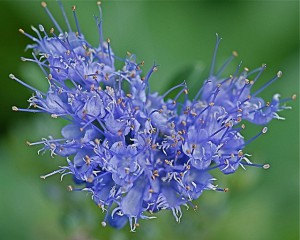
Caryopteris closeup (Photo by Janice Tucker)
Choose the Blue Mist spirea to add a bit of heavenly blue to your garden. It is great as a stand-alone shrub, planted en masse to create a hedge or as a backdrop for lower growing flowers. Whatever role the Blue Mist spirea plays, your garden will be happily singing the blues.


